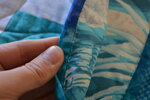



Quilt care is about more than maintaining fabric and stitching quality. It’s about safeguarding the memories attached to the blanket. Many quilts, vintage or new, are heirloom items that will be passed to various generations, and preservation requires gentle treatment.
Susan Engelking, owner of Country Manor Fabrics in Battle Ground, has worked with many quilters since her shop opened in 1985. Sometimes, even non-quilters arrive with an heirloom blanket in search of answers, Engelking said.
“It’s interesting what we have in our lives that are important to us,” Engelking said. “Maybe you don’t have a picture of the person, but you have something that they made.”
Quilt maintenance is important, but it’s not something to be done frequently, she said. A hand-sewn quilt should only be washed two times a year.
“If your quilt is damaged by soil or aging, the best thing to do is use a presoak like Biz [laundry detergent] and soak it in the bathtub,” Engelking said. “Put your quilt in there and soak it overnight. After you take it out, rinse it.”
Gentle agitation, like swishing and squishing with hands, may be OK, but Engelking encourages quilt owners to simply let it soak.
“Be careful with it, especially if it’s hand-quilted,” Engelking said. “If it’s machine-quilted, you may be able to agitate it on a gentle cycle in your washing machine. It’s best to handle it very carefully.”
After washing, Engelking recommends laying the quilt flat on a sheet to dry. To speed up drying, quilt owners can gently pat the blanket dry with towels. Hanging the quilt to dry can damage it.
“Don’t drape it over anything because, if it has any water left in it, it will distort the shape of the quilt,” Engelking said. “The weight is also hard on your stitching.”
To avoid washing a quilt, Engelking recommends frequently airing out the cloth. Leaving a quilt in plastic storage, or in a poorly ventilated closet, can cause it to mold or form dappled orange “rust spots” on the fabric.
“If you take them out in the air, that freshens them up, takes the odors away and just gives it the chance to live again and breathe,” Engelking said.
Though air helps freshen quilts, Engelking recommends keeping them out of the sun. Sunlight can change the color of the fabric and weaken the threads.
The best way to preserve a hand-sewn quilt is with machine sewing, Engelking said. Many vintage blankets are hand-tied or stitched, which are more likely to tear and not as strong as machine-sewn stitches.
“Sometimes machine quilting on an older quilt that has been tied helps hold it together if your fabrics are fragile,” Engelking said.
There are many ways to machine sew a quilt. Some quilts look best with swirling, intricate stitching patterns. Others look nice with simply sewn rows. Engelking recommends shopping around for a professional quilter who can pick designs and thread colors to best suit the quilt.
Many quilting guilds across Clark County, such as Clark County Quilters, North Star Quilters and North Clark Historical Museum, have professional quilters. Many churches also have talented individuals with quilting machines, Engelking said.
Engelking’s store, Country Manor Fabrics, 7702 NE 179th St., Battle Ground, also offers an array of quilting resources. To learn more, visit countrymanor.qwestoffice.net.